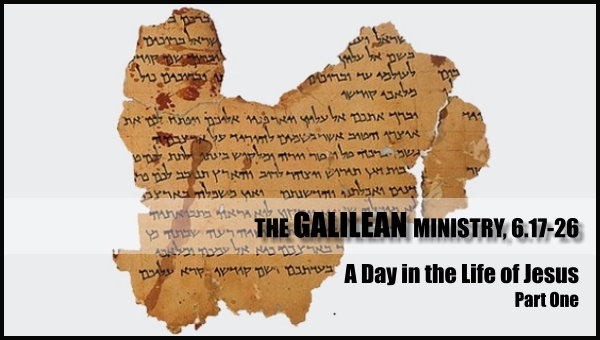By Tyson Thorne

The Galilean Ministry at Various Cities (4.14-9.50), 6.17-7.50 - A Day in the Life of Jesus, Part One
We have been able to discern what a typical Sabbath day was like for Jesus during his ministry years, including a time of teaching and sometimes healing in the synagogue followed by a walk and supper at someone’s home. Over the next couple chapters (6.13-7.50), we get a detailed look at a typical day in the life of our Savior. Due to the length of the writing we cannot possibly cover everything in a single post, so we’ll be breaking it up but try to keep in mind that these are not random teachings of Jesus, they represent roughly a 12-hour period.
Following a night of prayer, Jesus selected the 12 disciples and lead them down from a mountain into a plain where they were greeted by a multitude of followers from all around the surrounding area and as far away as Jerusalem and even the coast of the Mediterranean. After healing many who were sick or demon possessed he turned toward his disciples and began to teach. We should stop here and define the groups present.
First, there is Jesus and the twelve, the inner circle. The men he had just selected to be his closest disciples are those who will live with Jesus 24 hours a day. They will see him in various circumstances and witness his reaction to every event. The second group are also called disciples, and they are present in a significantly large number. These are people who follow Jesus but go home at the end of the day. This is the group that Jesus is addressing in this “Sermon on the Plain” that extends to the end of this chapter. Then there are the multitudes, people who have heard of Jesus’ reputation and are intrigued to see him for themselves, people who are afflicted with various illnesses and people in need of spiritual care. The fourth and final group are religious leaders attending in the hopes of catching Jesus doing something worthy of arrest and possibly worse.
Verse 30 tells us that Jesus looked up at his disciples and began to teach. This is the larger group of disciples, not only the 12. Everyone else present is welcome to stay and listen in but the priority is clearly those devoted to following Jesus. How many churches today wish for as many seekers as Jesus had present? He begins teaching and it sounds suspiciously like the Sermon on the Mount. I imagine Jesus taught many concepts repeatedly and on different occasions, so don’t let this confuse you.
Jesus opens his message with a series of blessings and curses. This is an ancient form of wisdom literature that developed over about 1,800 years before Jesus and ending with his stylistic modifications. Take Psalm 2.12 for example: “Blessed is the man whose sin is forgiven”. Later the “woes” accompanied the blessing. Jesus added another element, that of a future hope or future curse to the formula. So the beatitudes of Matthew and Luke sound a bit like God’s Word found in the Old Testament, but have an added New Testament twist.
It is interesting to note that verses 20 through 26 were found among fragments contained in the Dead Sea Scrolls. They are the same as the text we have today in later manuscripts. Best estimates, based on the style of writing, place the age of the manuscript between 50 BC and 50 AD. Since it could not have been written before Jesus spoke these words it places the date between 30 and 50 AD. This is 130 years earlier than previously found New Testament fragments of this passage, and places it no later than 20 years of Jesus’ sermon and possibly even during his life! This further supports the accuracy of the New Testament. (“Dead Sea Scrolls Research Council: Fragments: The Beatitudes and Woes in the Sermon on the Plain,” Biblical Archaeology Review 18.6 (Nov/Dec 1992): 54.)
Tomorrow we will look at the meaning behind these blessings and woes.
|
|